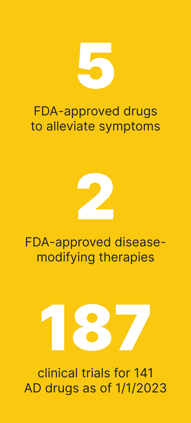One in nine Americans age 65 and older has Alzheimer’s disease (AD), a devastating illness that wipes patients’ memories and robs family and friends of their loved one even before the patient succumbs to the disease.1 As a person gets older, the risk of developing Alzheimer’s increases and by 2030, 20% of the U.S. population is expected to be age 65 or older, so that number could increase dramatically.1
Currently, there are no cures for this progressive and fatal form of dementia; however, there are seven FDA-approved drugs on the market and 187 clinical trials in progress, researching 141 AD drugs.1,2 But development of these vital treatments for this complex illness is not without its hurdles. With June being Alzheimer’s & Brain Awareness Month, we will explore synchronized solutions that advance the science.
 Selecting ideal clinical trials sites
Selecting ideal clinical trials sites
The Alzheimer’s Association reported that clinical trial sites for memory impairment drugs do not cohesively align with areas that have larger populations of individuals 60 years of age and older, causing strain on sites in areas of higher density senior populations and leaving other individuals having to travel 50 miles to get to a clinical trial site. This has led to lower performance and delayed timelines.3 Additionally, Alzheimer’s disease disproportionately affects minorities, with 19% of Black/African American and 14% of Hispanic/Latino adults age 65 and older having AD, compared to 10% of White/Caucasian seniors.1
The HealthVerity Provider Diversity Index (PDI), a nationally-syndicated report that leverages medical, pharmacy and social determinants of health data from the nation’s largest healthcare and consumer data ecosystem to calculate the demographic composition of patient populations for over 2 million healthcare providers, offers a HIPAA-compliant tool to aid researchers in recruiting patients reflective of the population impacted by the condition being studied. The definitive guide provides patients’ race, gender, income range, payer type, age range and diagnosis code. Using this report, researchers can easily discover physicians that have representative patient populations to identify optimal clinical trials sites and improve recruitment.
Data to demonstrate efficacy
In order for new Alzheimer's drugs to be accepted by doctors, payers, regulators and, most importantly, patients, pharmaceutical companies need to create a robust body of evidence that demonstrates product safety and effectiveness in the real world. This presents unique challenges, because traditional sources of real-world data (RWD), such as claims or electronic medical records (EMRs) alone, do not capture key measures of AD progression.
With the nation’s largest healthcare and consumer data ecosystem, representing over 4 million diagnosed AD patients, HealthVerity offers the most novel and diverse data sources, including:
- Infusion center data to capture how the latest AD products are being prescribed in the real world
- Long-term care EMR data to analyze cognitive test scores over time
- Genetic lab testing data to understand the presence of the APOE-e4 gene, commonly associated with AD
- Open and closed payer claims to reveal the AD patient’s longitudinal healthcare journey with the most extensive commercial, Medicaid and Medicare coverage
- Outpatient lab results representing 65% of the outpatient market for the detection of beta-amyloid proteins in spinal taps
All of this data is fully interoperable, privacy-protected and delivered directly to your environment of choice in a normalized common data model for you to apply fit-for-purpose analytics.
A synchronized solution
With nearly 14 million people projected to have Alzheimer’s disease by 2060, it is imperative that we find ways to prevent, slow or cure the condition.1 HealthVerity synchronizes transformational technologies with our vast RWD ecosystem to power previously unattainable outcomes that can help you fundamentally advance AD research and treatment development.
Using our IPGE approach, we synchronize Identity management to provide unparalleled accuracy in matching patient identities across disparate sources, with built-in Privacy and Governance of data rights and usage permissions, to enable the discovery and exchange of a near limitless combination of data at a record pace. This synchronized approach offers the most comprehensive view of the AD patient journey, providing the real-world evidence to help accelerate research and, hopefully, slow the progression of Alzheimer’s.
Click here to schedule a demo of the HealthVerity data ecosystem.
1 Alzheimer’s Association. 2023 Alzheimer’s Disease Facts and Figures. https://www.alz.org/media/Documents/alzheimers-facts-and-figures.pdf.
2Cummings, J.; Zhou, Y.; Lee, G.; et al (2023). Alzheimer’s disease drug development pipeline: 2023. Alzheimer’s & Dementia. Volume 9, Issue 2. April-June 2023.
https://alz-journals.onlinelibrary.wiley.com/doi/full/10.1002/trc2.12385
3 Stanton, S.; Dwyer, J.; Ward, N.; Vradenburg, G.; Taylor, J. (2020). Are U.S. clinical trial sites in the right places to meet the demand for the population density of those over 60? Alzheimer’s & Dementia, vol. 16, issue 10, December 7, 2020. https://alz-journals.onlinelibrary.wiley.com/doi/10.1002/alz.044244





